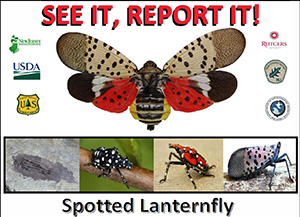Spotted Lanternfly Information

Spotted Lanternfly is an invasive pest that has been found in Mercer County that threatens NJ agriculture. The State of New Jersey is requesting your help in the effort to control its spread! If you think you see it in any of its life stages on a property within West Windsor Township, please report your sighting to the Township at
All of Mercer County is under a Quarantine in an attempt to prevent the spread of this pest to other areas. Movement of certain articles that can spread the pest is being regulated, and a Permit is required for those who routinely move vehicles, products or other means of pest conveyance into or out of the Quarantine Zone.
Stop the Spread
When you travel in and out of the quarantine zone, check your car and any outdoor items you are moving (grills, outdoor furniture, landscaping supplies, mowers, etc.). Check for SLF egg masses from September through June. Remember that egg masses may be underneath your car or in your wheel wells. During all other times of the year, check for nymphs and adults, and keep your windows rolled up when you park. Don't store things or park under infested trees, and don't move firewood.
Steps of Spotted Lanternfly Management
- Stop the spread
- Scrape egg masses
- Use tree traps to catch nymphs
- Remove host plants
- Apply insecticides
Egg Scraping
Walk around your property to check for egg masses on trees, cement blocks, rocks, and any other hard surface. If you find egg masses on your property from September to May, you can scrape them off using a plastic card or putty knife (Figure 3). Scrape them into a bag or container filled with rubbing alcohol or hand sanitizer and keep them in this solution permanently. Egg masses can also be smashed. Remember that some eggs will be unreachable at the tops of trees, in other well-hidden areas, and throughout your neighborhood and community. Be aware that this method may not reduce the number of nymph or adult SLF you see later in the year.
| Date Posted | Information |
| August 21, 2020 | SLF SEE IT, REPORT IT! Spotted Lanternfly (SLF) Facts and Instructions |
| August 21, 2020 | SLF Identification Card |
| August 19, 2020 | https://extension.psu.edu/spotted-lanternfly-management-for-residents |
| August 19, 2020 | https://extension.psu.edu/online-newsletter-provides-updates-recommendations-on-spotted-lanternfly |
| August 20, 2018 | Checklist for Residents Living in Spotted Lanternfly Quarantine Areas |
| August 20, 2018 | What the New Spotted Lanternfly Quarantine Means for You |
| August 20, 2018 | USDA Pest Alert |

